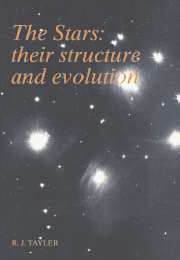Book contents
- Frontmatter
- Contents
- Preface
- Symbols
- Numerical values
- 1 Introduction
- 2 Observational properties of stars
- 3 The equations of stellar structure
- 4 The physics of stellar interiors
- 5 The structure of main sequence stars and pre-main-sequence evolution
- 6 Early post-main-sequence evolution and the ages of star clusters
- 7 Mass loss from stars
- 8 Close binary stars
- 9 Advanced evolutionary phases
- 10 The final stages of stellar evolution: white dwarfs, brown dwarfs, neutron stars and black holes
- 11 Concluding remarks
- Appendix 1 Thermodynamic equilibrium
- Appendix 2 The equation of radiative transfer
- Appendix 3 The pressure of a degenerate gas
- Suggestions for further reading
- Index
- Frontmatter
- Contents
- Preface
- Symbols
- Numerical values
- 1 Introduction
- 2 Observational properties of stars
- 3 The equations of stellar structure
- 4 The physics of stellar interiors
- 5 The structure of main sequence stars and pre-main-sequence evolution
- 6 Early post-main-sequence evolution and the ages of star clusters
- 7 Mass loss from stars
- 8 Close binary stars
- 9 Advanced evolutionary phases
- 10 The final stages of stellar evolution: white dwarfs, brown dwarfs, neutron stars and black holes
- 11 Concluding remarks
- Appendix 1 Thermodynamic equilibrium
- Appendix 2 The equation of radiative transfer
- Appendix 3 The pressure of a degenerate gas
- Suggestions for further reading
- Index
Summary
This book is concerned with the structure and evolution of the stars, that is the life history of the stars. Its aim is to show how observations of the properties of stars and knowledge from many branches of physics have been combined, with the aid of the necessary mathematical techniques, to give us what we believe is a good understanding of the basis of this subject.
Because the stars are so remote from the Earth it may seem surprising that we can learn anything about their physical dimensions. To hope to be able to describe their internal structure and, still more, their evolution appears extremely optimistic. The mass and radius of a few stars can be measured directly, but for most stars the only source of information is in the light that we receive from them. This gives us some idea about the temperature and chemical composition of the surface layers of the star and about the total light output (luminosity) of those stars whose distance from the Earth is known. It also indicates that some stars are rotating rapidly or have strong magnetic fields and that others are losing mass from their surfaces. No direct information is obtained about physical conditions in the interiors of the stars, with the exceptions (discussed in Chapters 4 and 6) that the neutrinos emitted in the solar centre can be detected on Earth and that vibrations of the solar surface can provide information about the interior by techniques similar to seismology.
- Type
- Chapter
- Information
- The StarsTheir Structure and Evolution, pp. 1 - 7Publisher: Cambridge University PressPrint publication year: 1994



